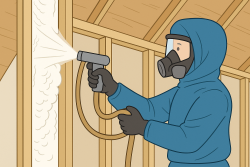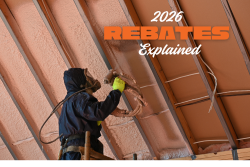Blowing-in cellulose insulation is a loose-fill material frequently used when installing insulation in closed walls or attics. It is made from recycled newspapers or other paper products that have undergone chemical treatment to make them both bug and fire-resistant. Cellulose insulation is blown into walls, attics, and other building areas, filling every nook and cranny.
Due to its energy efficiency, cost-effectiveness, ease of installation, and environmental friendliness, it is a popular insulation choice for residential and commercial buildings. Read this article to learn more about blow-in cellulose.
How Cellulose Insulation Is Blown Into the Home
A blowing machine or insulation blower is used to blow cellulose insulation into a home. The steps typically involved in the process are as follows:
- Insulation is installed by drilling a small hole into the wall, attic, or other areas.
- We connect the blower to the hole and turn it on.
- An insulation machine blows cellulose into a target area after it is fed into it.
- It is blown until the desired depth and coverage are achieved.
- Air leaks are prevented by sealing the hole after installing the insulation.
High velocity and pressure are used to blow in the cellulose insulation, which allows it to reach tight spaces and fill all the nooks and crannies of the area to be insulated. As a result of this process, a tight seal is achieved, and the insulation coverage is maximized. Depending on the size of the area to be insulated, the process can be completed in a matter of hours.
Benefits of Blow-in Cellulose
It Enhances Energy Efficiency
Among the available insulation materials, blow-in cellulose insulation is regarded as one of the most energy-efficient options. It may efficiently insulate your home, lowering your energy expenditures, and it has a high R-value, a measurement of thermal resistance. Utilizing cellulose insulation to insulate your home can help to lessen heat gain during the summer and loss during the winter. Cellulose insulation can increase your comfort by maintaining a more constant interior temperature.
Environmentally Friendly
Insulation made from cellulose is environmentally friendly because it is made from recycled paper products. Cellulose insulation makes good use of large amounts of discarded newspaper and cardboard. There is more than 70 percent recycled paper in cellulose insulation. As cellulose insulation is made from natural materials, it is free of harmful chemicals and toxins. In addition to being fire-resistant, cellulose insulation has a long lifespan, reducing the need to replace it frequently.
It is Economical
Homeowners can choose blow-in cellulose insulation because it is relatively inexpensive compared to other insulation materials. Since cellulose primarily consists of paper, it is an even more affordable insulation option, costing approximately 75% less than fibreglass. In addition, cellulose is manufactured by hammer-milling, which is quite simple and inexpensive, making it one of the cheapest insulation materials.
Easily Installed
Cellulose insulation is installed using a blowing machine. The product is made from recycled paper products and can be easily installed in attics and other hard-to-reach places. It can be added to existing insulation to raise a building or home's insulation value. Blown-in insulation can fill small crevices and spaces that other types cannot, making it an excellent option for retrofitting older homes. Since blow-in cellulose insulation is relatively easy to install, homeowners often do it themselves.
Provides Excellent Soundproofing
Blow-in cellulose insulation improves soundproofing by reducing sound transmission through walls, floors, and ceilings. The density and ability of blow-in cellulose insulation to fill small crevices and spaces make it an excellent soundproofing material. Due to its high density, cellulose insulation absorbs sound waves and reduces their transmission. Small fibres in cellulose insulation fill small gaps and spaces, creating a tight barrier against sound. As a result, the sound is absorbed and diffused, reducing noise transmission and creating a more pleasant interior.
A professional insulation contractor should install blow-in cellulose insulation because they have the specialized equipment to install it properly. A contractor has the knowledge and experience required to properly install blow-in cellulose insulation so as to maximize its effectiveness.
Also, see our article"Helpful Tips To Improve Wall Insulation."
Contact Reitzel Insulation
Reitzel insulation is a leading insulation company serving Kitchener-Waterloo and surrounding areas. We have the expertise, tools, and know-how to handle any insulation project. The main goal of our company is to take care of your insulation needs as soon as possible.
.jpg)
















